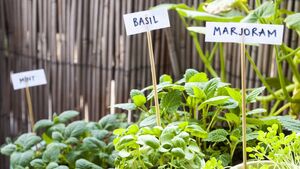Living Greener: Herbs are an easy way to grow own food

All of us have room for herbs
When you look in cookbooks from a hundred years ago, the recipes seem fairly bland to our taste, as they rarely call for herbs and spices.
Cookbook writers in those days assumed that everyone would add herbs to taste as they saw fit, and they assumed that everyone had an herb garden.
If you don’t have much practice growing your own food, herbs make an easy way in. Many herbs are quite hardy and forgiving of amateurs, and while some are annuals like most vegetables (dill, coriander), some last two years (parsley), die back and return each year (lovage) or survive the winter (rosemary). Also, if you grow too much or too little of something, your cooking will survive.
Don’t grow things of the same family close together, like dill, coriander and fennel, as bees could cross-pollinate them and destroy the flavour.
Rather, grow herbs in a few places around the house, splitting families between herb beds.
The most obvious herb might be parsley, which we treat as an all-purpose herb, heaping it into a wide variety of dishes for vitamins and flavour.
Parsley does well in pots, even inside, so long as the pots are deep enough to hold its substantial tap root and so long as it is maintained with rich, moist soil.
Its cousin, coriander, appears in Asian cooking, although people are divided on its strong flavour. A small but significant percentage of the population carries a gene that allows them to detect an alkali chemical in coriander, and while it’s harmless to us, apparently it tastes soapy and unpleasant.
Some of the most common and easiest herbs are familiar to most of us – rosemary, thyme, oregano, lavender, bay leaf, sage, tarragon, savoury and lovage. All these tend to survive the winter easily, draw bees in spring and grow thickly. In cooking terms, however, a little bit of these herbs go a long way, so you will almost certainly have more than you need.
Anything in the mint family — spearmint, peppermint, chocolate mint, apple mint or lemon mint — is easy to grow; as my family used to say, you just drop the seeds and run. Some gardeners complain that it takes over everything, but it’s easy to cut back, and there are worse things than having a yard of mint. It smells nice, feeds the bees, acts as a breath freshener and an ingredient in many home remedies. A bit of it does well in salad, and it makes a great jelly.
Chamomile grows wild on our land, and we love gathering the flower heads and drying them for tea; chamomile tea has long been used for relaxation and stomach troubles.
Some people make chamomile oil by adding the dried flower heads to a jar, pouring in olive oil and leaving in the sun for a month. If they’re not growing wild on your property, get some seeds from irishseedsavers.ie; they like well-drained soil and lots of sunshine.
Lemon balm, or Melissa, has long been used in herbal medicine as an antiseptic, a cure for toothaches, to treat depression and as a love charm, among other things. It is best used raw in small doses as an ingredient in dips, salads and tonics.
We love sorrel, which grows back every year without much trouble. It has a distinctively tart flavour -— the name comes from the French “sourelle,” or sour — and makes a great addition to salads. Take care to eat it only in small doses— it contains a lot of oxalic acid that can harm your kidneys if you take it too much or too frequently.
One of our favourites, which we recommend to any gardener, is borrage, an herb with a long and noble history. Its delicate lavender flowers are beloved of bees, and it requires almost no maintenance. Taken raw the leaves and flowers are hairy and a bit prickly, but finely chopped it makes a great addition to salads, dips and teas.
Not all of us have the time, space and inclination to grow rows of crops in a garden, or to build a polytunnel to foster Mediterranean plants. All of us, though, have room for herbs, whether in an indoor pot, a window box, or a front porch, and all of us can put in the minimum effort needed to grow them.
Finally, a reminder that my new book, , is now on sale from Academica Press. It pulls together hundreds of interviews with elderly Irish people to pass on the skills and wisdom that society has forgotten.





